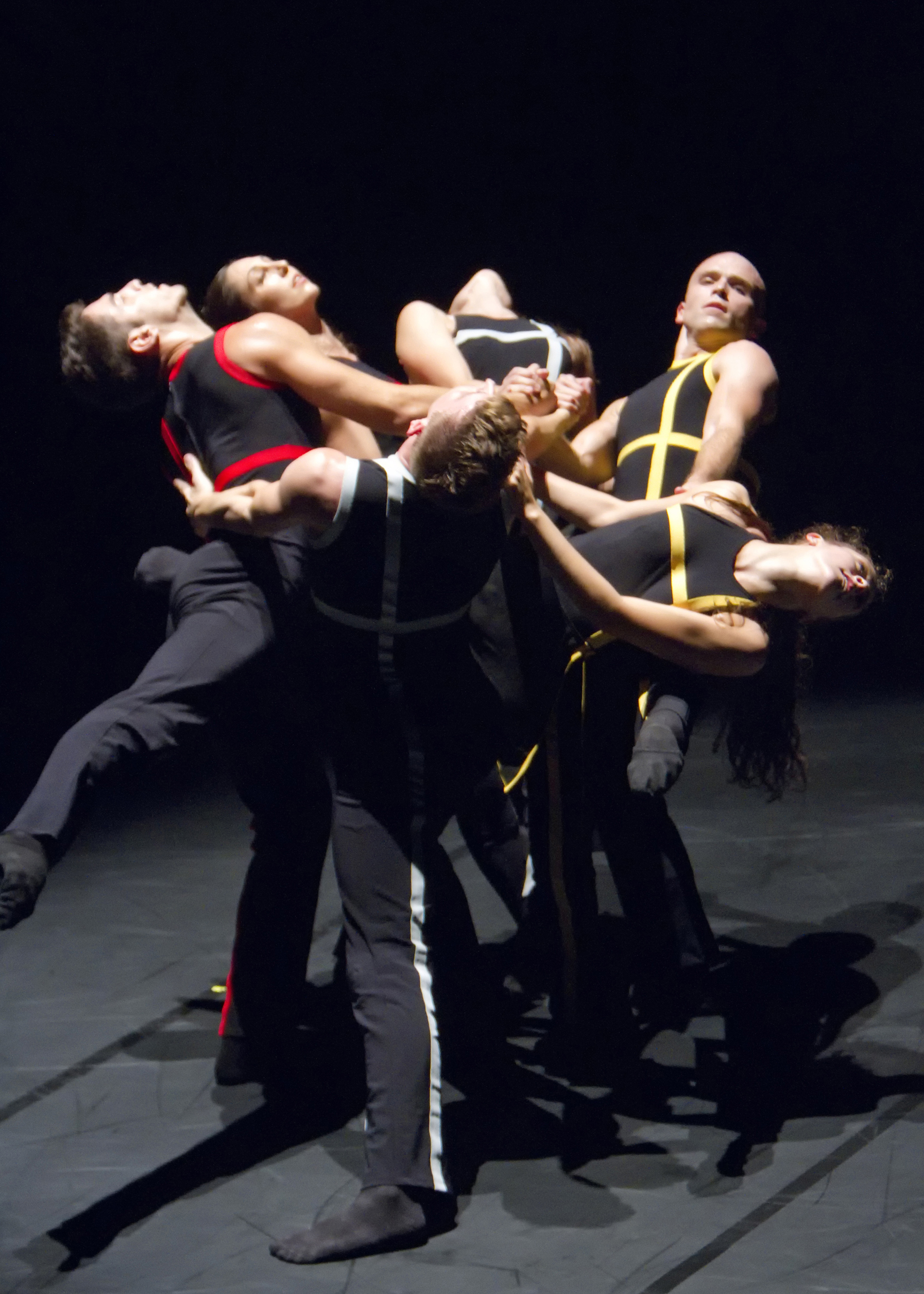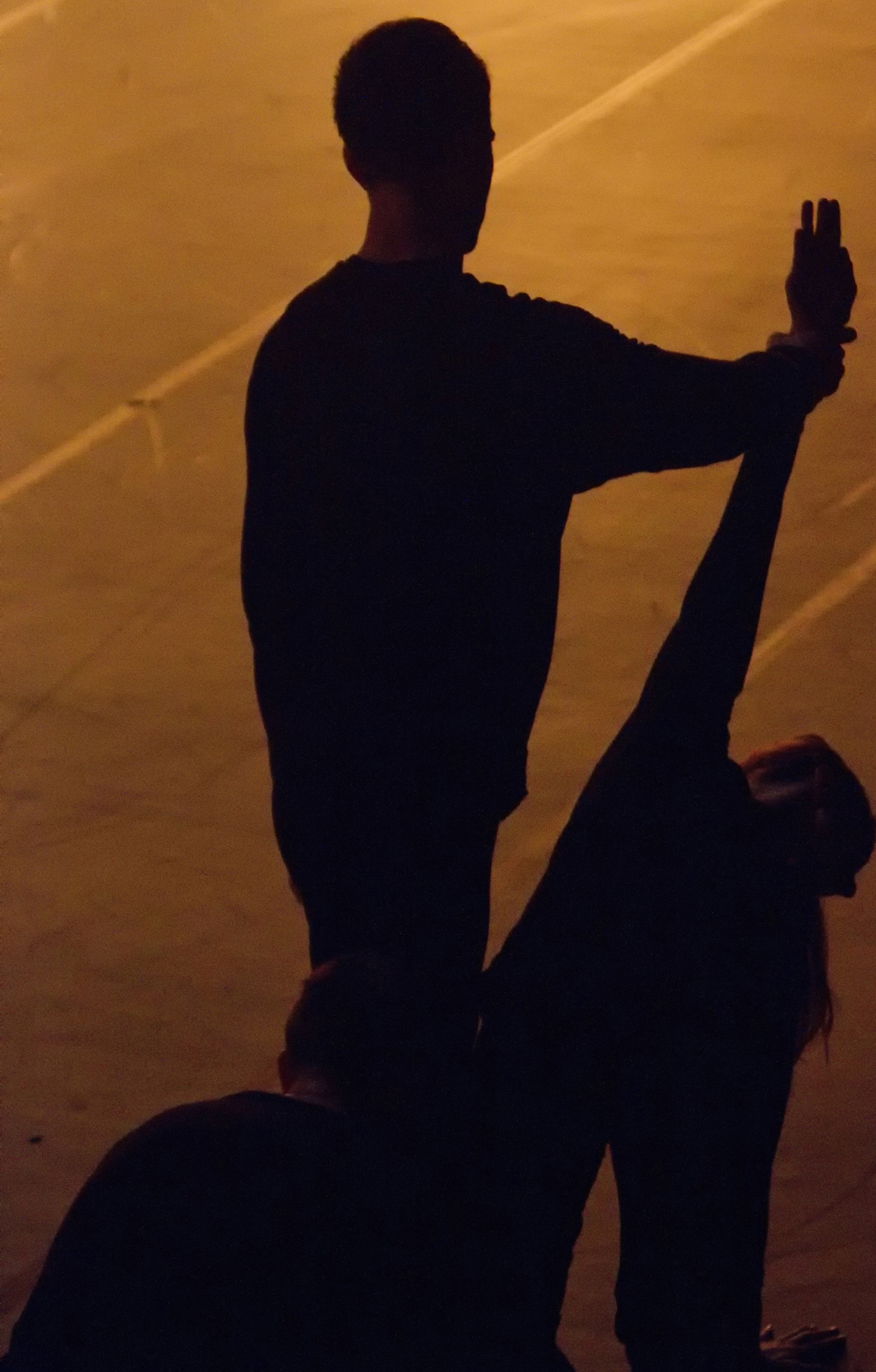
Benjamin Millepied’s “Moving Parts.” Clockwise from upper right: Charlie Hodges (face in view), Frances Chiaverini, Nathan Makolandra, Morgan Lugo, Amanda Wells, Julia Eichten. Photo: Eric Politzer
[UPDATE: Less than a year into this project, Millepied announced he was moving to Paris Opera Ballet, where he was offered the artistic director position. Since then, as the company toured the US and Europe, a series of exciting appointments unfolded: in 2014 James Fayette, another former City Ballet principal, became the company manager and in 2015 retiring Pacific Northwest Ballet principal Carla Körbes joined the company as associate artistic director.]
To achieve beauty, miniatures need to craftily convey the intact form of their full-sized brethren. And while the premiere performance of Benjamin Millepied’s chamber-sized L.A. Dance Project at the Walt Disney Concert Hall last weekend had some distorted features, the overall effect of this tight, six-member dance company was of a satisfyingly shapely and whole entity that delivered some good news to the LA dance community. Millepied’s recent stage forays here did not lead me to anticipate that this would be such a strong, memorable event.
Small dance companies fare best with a tight, heightened focus, and Millepied’s stated determination is that his entity exist as a collective of designers, musicians and choreographers as well as a staging area for past multimedia masterworks. And while his own dance-making may still be young, Millepied’s programming choices — William Forsythe’s “Quintett” (1993) and Merce Cunningham’s “Winterbranch” (1964) — were two clear, exciting examples of historic works that merge small casts with strong, expansive visual and aural designs that deepen the choreography’s meaning and effect.
Design synergy like that is hard to come by, however, and there wasn’t much to speak of in the world premiere of “Moving Parts,” (2012) Millepied’s busy, abstract work featuring shifting scenes of soloists, duets and group huddles amidst an ever-shifting stage set. Millepied’s lack of interaction and development with the emotional variations in Nico Muhly’s tender and jaunty score (for organ, violin and clarinet) plus way too much inconsequential interaction with Christopher Wool’s weirdly feeble panels (jumbles of font styles and scribbles) made for a sense of hitches and missed opportunities throughout the ambling work. Though flattering, the sleek black costumes by Kate and Laura Mulleavy of Rodarte seemed not of a part with the other elements.
“Moving Parts” did clearly signal the virtuosity and cohesion of the six formidable dancers in this troupe, however. The unassuming, compact Charlie Hodges (an award-winning veteran of Twyla Tharp productions) may be one of the most communicative dancers I’ve ever seen — when he enters the stage in a bright, declarative solo, he delivers each step so clearly, and strings them together so stylishly, it doesn’t even matter that the ‘news’ he’s announcing is nothing but word soup. Hodges’ physical enunciation is that endlessly watchable. The rest of the company members were more notably limby and leggy, and “Moving Parts” featured distinct moments for each of the troupe’s strong, sinuous women (Julia Eichten, Amanda Wells and Frances Chiaverini) plus a playful male duet (Nathan Makolandra and Morgan Lugo) where the guys’ lengthy arms and legs made for wonderfully angular, oversized gestures of connection and support.
With its flaws, “Moving Parts” still felt to have more style and more depth than any of the other Millepied works to play L.A. this year. And it would take a true masterwork to follow on the heels of Forsythe’s tricky, lyrical lexicon in “Quintett” (1993) and the genius union of Cunningham, Robert Rauschenberg and La Monte Young in“Winterbranch” (1964). Though both works suffered when situated inside the Disney stage’s bowl (its huge rise of seats behind the stage renders the crucial rectangle of back wall a foreshortened entity), here were two works with organized, focused concepts.
Though it was the Cunningham piece — with its shadowed stage and assaulting score — that rattled audiences last weekend (during the Sunday matinee the man sitting in front of me booed angrily at the curtain call; others hissed collaboratively), to my mind the aural attack was of a perfect piece with the work’s visual starkness and gravity — a perfectly dark, unnatural moment, like so many we endure. The seized human shapes of “Winterbranch” (when they’re not falling, women are frequently carried from place to place) merged brilliantly with the flashing lights and blaring score to emit a scene so simultaneously blank and suggestive that the piece gets interpreted by each audience as a specific reference its own cultural atrocities (post-Holocaust, post-atomic bomb, etc). In Los Angeles, it can’t help seeming like the scene of roadway terror and urban seige.
For me, it was the repetetitive loops of Gavin Byars’ “Jesus Blood Never Failed Me Yet” that irked more, perhaps due to the diminished synthesis with other stage elements in this venue. Forsythe’s lighting design for the back wall read dimly and had no consequential power. Yet again, the strength of the dancing carried this piece, particularly Frances Chiaverini’s daring shifts of weight during her off-kilter turns and drops and Charlie Hodges’ amazing directional shifts in his turn sequences.
This unique venue and its patrons’ possessive attitude towards it had one benefit in that it made for such an engaged, expressive audience — which isn’t a bad thing for a dance. The opposite is much worse.
